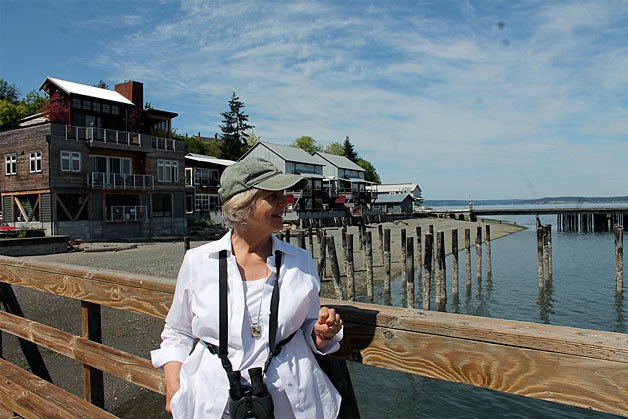As she stands with her hummingbird hat perched on her head and binoculars firmly in hand, Frances Wood patiently awaits the flutter of wings or the tune of a bird’s song. It’s an indicator that she’s found what she is looking for. It doesn’t take long — Wood has done this many, many times before. The puttering of wings and a rapid chirping sound off in the distance and without raising the binoculars to her face, Wood can almost immediately identify her avian friend.
“It’s a pigeon guillemot,” Wood said.
Wood is a longtime Langley resident and naturalist whose expertise is the study of birds, specifically seabirds. Her passion for the winged creatures led her to publishing a book, “Brushed by Feathers: A Year of Birdwatching in the West” in 2004, as well as conducting a research project on the aforementioned pigeon guillemot. A past president of Whidbey Audubon Society, Wood is an experienced birdwatcher and still guides fellow birders today.
She’s also a longtime bird columnist for the South Whidbey Record.
Wood will be applying her expertise to lead a birdwatching tour sponsored by Whidbey Audubon from 8-11 a.m. Saturday, April 30 for Whidbey Earth and Ocean month. Wood will take guests to a few of her favorite birdwatching spots on the South End, the locations determined by the head count. All are encouraged to come, from the novice to the experienced birder.
Tour guests will meet at the Bayview Park & Ride, carpooling will be assigned upon arrival. Guests are encouraged to bring their own pair of binoculars, and the trip will end before lunchtime. Admission is free.
According to Wood, spring is a hot time of year to birdwatch as many species are migrating through the Puget Sound region.
“What we’re beginning to see now is that five species of swallows are coming to the island to breed,” Wood said. “We should also see a lot of warblers since they usually migrate through here at the end of April. There will mainly be forest and marsh birds.”
Whidbey Island is a wonderful place to birdwatch, according to Wood. The Puget Sound region is a major point in many species’ migratory patterns, and the surrounding saltwater provides habitat for a multitude of seabird species, leaving a wide variety of birds that call Whidbey a permanent or temporary home. The tour will seek out a whole gamut of species, including raptors (taloned birds), osprey, woodpeckers and a host of others.
“Whidbey really is a special spot for birding because you get to see a variety of birds,” said Ann Casey, immediate past president of Whidbey Audubon Society. “I didn’t used to be into birding myself until I heard about a Whidbey Audubon Society birdwatching tour. I’ve been going birding ever since.”
As the weather changes with the seasons, so do the bird species that live in and around the South End. The winter months offer some of the best opportunities to see seabirds, while spring brings migratory swallows, warblers and a range of forest and marsh birds. Autumn is a great time to see the resident birds that Whidbey has to offer, including the sparrows, owls and raptors.
“It’s a wonderful place to birdwatch,” Wood said. “You wouldn’t be disappointed any month of the year since there’s so much going on.”
According to Wood, birds are closely connected to the celebrations of Earth Month since they are an indicator species, or a species that act as immediate responders to danger and changes in their environment. A current example to look at is the small amount of swallows that migrated through the South Whidbey area this spring. When looking at this phenomenon, environmentalists are offered insight into what is happening with the birds’ natural habitat — whether a matter of habitat destruction or depletion of the birds’ food source.
“We have to maintain the forests we have so the birds still have a habitat,” Wood said. “I hope that all people realize the importance of the stewardship role that we all have. I really encourage people to find their passion in nature.”
Wood’s current venture is a research project she is conducting with some of her fellow birders on her favorite bird species, the pigeon guillemot; her research is slated to be published in a scientific journal in the fall. She still finds time to go birding and spread her knowledge to birders of all experience levels. There isn’t anyone better-equipped to instill a love for birds and the environment than Wood, according to Casey.
“Anyone who is lucky enough to go on a field trip with Frances is in for a treat,” Casey said. “She’s an outstanding educator and she is a highly experienced international birder. She’s very welcoming and encouraging for beginners.”


